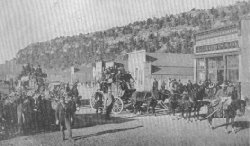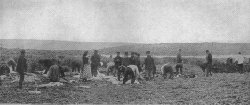The Yukon is 20 miles wide, 700 miles from its mouth. With its tributaries, it is navigable for 2,500 miles. It discharges one-third more water than the Mississippi. The territory of Alaska has an area of 329,529,000 acres, of which 272,000,000 acres lie within the temperate zone. In 1867, the United States Government paid for this area $7,200,000. One Alaska company alone has paid to the United States Government $7,000,000 in rentals and royalties. The value of Alaska salmon packed in 1901 was over $7,000,000. The experience of the world shows greater trade in the temperate zone than in the tropics. Annual exports to Alaska amount to $1,000 per head. Annual imports from Alaska amount to $400 to $1,000 per head. Alaska is the American Sweden and Norway. It begins in a line within Southern England. Alaska does not extend as far north as Northern Norway. It is richer than Sweden and Norway. Kadiak, on the coast, is in the same latitude as Aberdeen, Scotland. The lowest temperature ever recorded at Kadiak was five degrees above zero. The average winter temperature at Kadiak is higher than at Washington, D. C. The lowest temperature ever recorded at Dutch Harbor, Alaska, was nine degrees above zero. Dutch Harbor is in the latitude of Liverpool. Sitka has not cold weather enough in winter to supply ice for the summer. Alaska is rich in minerals, lumber, fisheries, furs and coal. The trade with Alaska is now nearly twice as great as with Hawaii.
The breeding grounds of the seal which is of commercial value are principally the Pribilof Islands of St. Paul and St. George. This land was leased by the Alaska Commission Company for $60,000 a year, and a commission, or royalty, of $2 on every fur seal taken. The company was limited to 100,000 seals a year. This arrangement made by the Treasury Department was considered very favorable until the great movement of settlers west tempted pelagic sealing or hunting for fur seals in the water. So rapidly did the herds of seal begin to diminish that officials were alarmed, and in 1886, the revenue cutter, Corwin, was sent to the territory and three British vessels were seized for illegal hunting. This caused a great uproar, and a demand was made by Great Britain that the sailors be released. This was done, but, the next year, a similar proceeding followed. After much discussion and legislation, a joint high commission was appointed between Great Britain and the United States and the outcome of its work was a proposed set of regulations to protect the seals. These regulations, which were to continue in force until either party violated them, prohibited the killing (except by Indians) of seal within 60 miles of the Pribilof Islands at any time, and anywhere in the North Pacific from May 1 to July 1, of each year. This closed season allowed the seals time to cross from their winter quarters over the ocean to the Pribilof Islands to breed. Explosives and firearms (except shotguns) were prohibited in hunting. This stipulation, however, was not ratified, and the United States government was forced to prevent sealing on the Pribilof Islands except by the North American Commercial Company and to demand papers showing a complete record of every sealskin brought into our ports. This was a hard blow to Canadian interests, and tended to suppress pelagic sealing. In pelagic sealing, the hunters sail in schooners from our shores to Yokohama and thence bear down upon the animals in the sealing ground. The cry, "Sleepers", is the warning given by the lookout on shipboard that seals are in sight. A boat is lowered, provisioned for five days, and equipped with shotguns and shells. When the seals are espied they are asleep on their backs, with their flippers across their bellies. Stealthily, the hunters slip upon their quarry and shoot them asleep. Great quiet must be preserved until the killing begins, for, although the seals are almost blind, they have an acute hearing. At the Pribilof Islands, the government has built fences to confine the bull seals during breeding seasons. Walrus hunting is carried on in the Arctic seas by the Eskimos and is a very profitable but dangerous enterprise. The method pursued by these little people of the North is to cruise, about the sea, and when a walrus is sighted, to lower a whaleboat with about six men in it. Gently they steal upon the unsuspecting walrus, and when they come within about 20 yards of the animal, it is harpooned. The harpoon has a handle attached at one end, and on the sharp end is a movable barb. To the barb is attached a rope, which jerks the barb to a horizontal position when the spear is buried in the animal. This prevents the harpoon from drawing out. Now the walrus is enraged and tries to break away. It swims, with all its might and the natives shoot it with bullets from a Winchester rifle. So thick skinned is the animal that one shot will not suffice, and six or seven shots are often necessary. All this time it swims strongly. Finally, it can be drawn near enough to the boat to be stabbed with a lance through the heart and lungs. It is then towed to the ship and hoisted on board by means of pulleys. Here it is cut up. These great animals have valuable tusks and blubber, and average about 1,800 pounds each, in weight. FLORIDA'S PRODUCTS AND PLEASURE RESORTS |

